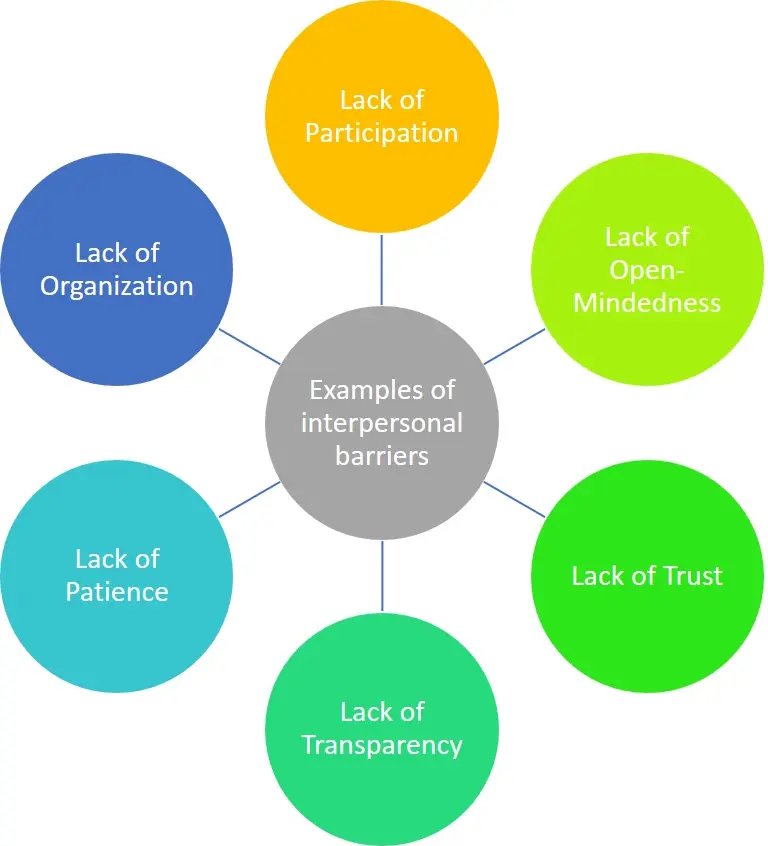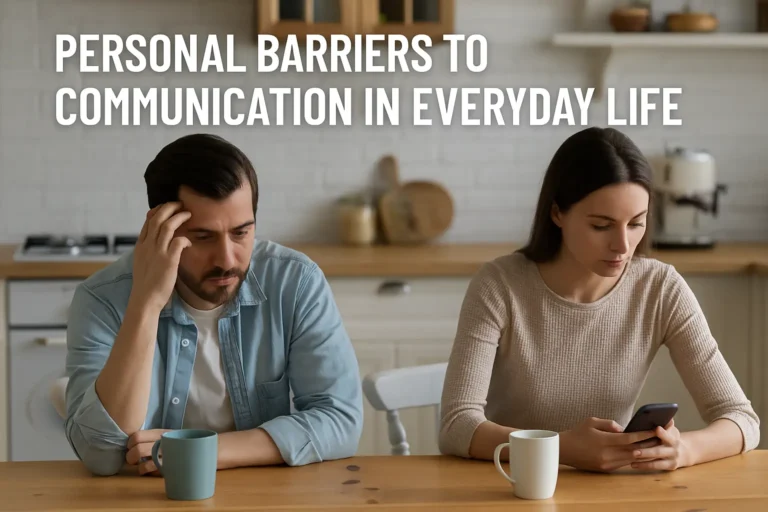Barriers to Interpersonal Communication
Interpersonal communication is the lifeblood of our personal and professional relationships. It enables connection, understanding, and collaboration. Many professionals face barriers to interpersonal communication that distort messages and trigger misunderstandings. These obstacles can damage relationships, create workplace tension, and stall personal growth. Misinterpretations often lead to lost opportunities and lingering conflicts. This article explores practical solutions to overcome these challenges and foster clearer, more effective interactions.
What Are the Barriers to Interpersonal Communication?
Effective communication can be obstructed by several types of barriers. Let’s review them with added research-backed insights:
Environmental Barriers
External factors such as background noise, poor acoustics, and unsuitable spatial arrangements can interfere with message clarity. Research by Smith et al. (2020) shows that ambient noise can reduce comprehension by up to 30% in work environments.
Actionable Tips:
- Optimize the Environment: Use soundproofing measures, high-quality audio equipment, and appropriate room layouts to minimize distractions.
- Plan Ahead: Schedule important conversations in quieter settings or use virtual meeting tools that allow for noise cancellation.
Language and Semantic Barriers
The use of jargon, ambiguous terminology, or culturally specific idioms can cause confusion, particularly when communicators have different language proficiencies or backgrounds. Jones & Lee (2019) found that simplifying language in diverse teams leads to clearer communication and reduces errors.
Actionable Tips:
- Simplify Your Message: Use plain language and avoid unnecessary technical terms.
- Clarify Meaning: Encourage questions and provide definitions for any specialized vocabulary.
- Tailor Communication: Adapt your language to the audience’s level of familiarity with the topic.
Psychological Barriers
Emotional states such as stress, anxiety, or pre-existing biases can distort how messages are sent, received, and interpreted. Daniel Goleman’s work on emotional intelligence (1995) suggests that managing emotional responses can significantly enhance communication clarity.
Actionable Tips:
- Practice Mindfulness: Engage in stress-reduction techniques before and during critical conversations.
- Self-Reflect: Recognize your emotional triggers and address them proactively.
- Empathy Training: Develop empathy by actively considering the feelings and perspectives of others.
Socio-Cultural Barriers
Differences in cultural norms, age, education, or organizational hierarchy can lead to varied interpretations of the same message. Hofstede’s cross-cultural research (2001) highlights that cultural sensitivity training can improve mutual understanding and reduce misinterpretation.
Actionable Tips:
- Cultural Competence: Participate in or facilitate cultural competency training.
- Inclusive Practices: Encourage dialogue that respects diverse viewpoints and adapts to different cultural norms.
- Active Engagement: Ask clarifying questions to ensure that messages are interpreted as intended.
Top 5 Communication Challenges in Today’s Workplace
Based on recent research and workplace studies, the following challenges have been identified as key obstacles in modern professional settings:
Cultural and Linguistic Differences
- Challenge: In a globalized workforce, variations in communication styles and language can lead to misunderstandings.
- Solution:
- Provide language support programs and cross-cultural training.
- Create inclusive communication policies that accommodate diverse linguistic backgrounds.
Remote Work Dynamics
- Challenge: Remote and hybrid work models often reduce the richness of non-verbal cues, leading to feelings of isolation and decreased interpersonal connection.
- Solution:
- Use video conferencing tools to preserve visual cues.
- Organize regular virtual team-building activities to maintain personal connections.
Digital Communication Overload
- Challenge: The overuse of emails, texts, and instant messages can result in information overload and diminished attention to key messages.
- Solution:
- Set clear communication protocols and designate “digital-free” periods for focused work.
- Utilize project management tools that consolidate messages and reduce email clutter.
Navigating Interpersonal Conflict and Emotional Situations
- Challenge: Conflicts can arise when emotions run high, and misinterpretations occur, particularly without the benefit of face-to-face interaction.
- Solution:
- Invest in conflict resolution training and mediation services.
- Encourage the use of “I” statements and active listening to de-escalate tension.
Feedback Challenges
- Challenge: Delivering and receiving feedback can be difficult, often leading to defensiveness or misinterpretation.
- Solution:
- Implement structured feedback frameworks such as the SBI (Situation-Behavior-Impact) model.
- Create a culture where feedback is seen as a tool for growth rather than criticism.
Real-World Examples of Communication Barriers

To illustrate these challenges, consider the following examples:
Lack of Participation
In a software development team, limited participation during cross-department meetings may be interpreted as disinterest. Regularly scheduled check-ins and interactive meeting formats can help overcome this barrier.
Lack of Open-Mindedness
During brainstorming sessions, dismissing new ideas can inhibit creativity. Fostering an environment where every idea is welcomed—perhaps through a “no judgment” round—can encourage more open dialogue.
Lack of Trust and Transparency
If team members withhold critical information, it may lead to rumors and mistrust. Regular updates, open-door policies, and clear communication channels help build trust and clarity.
Lack of Patience and Organization
Rushed meetings with no clear agenda can result in missed information and frustration. Preparing detailed agendas and setting aside adequate time for discussion ensures that all points are addressed.
Strategies to Overcome Communication Barriers

Enhance your interpersonal communication with these evidence-based strategies:
Active Listening
Focus fully on the speaker. Use techniques such as paraphrasing and asking clarifying questions. Research shows that active listening can increase mutual understanding by over 40% (Brown & Davis, 2018).
Clear and Concise Messaging
Avoid jargon. Use straightforward language and break complex ideas into simple parts. Tools like the “KISS” (Keep It Simple, Stupid) principle can be particularly effective.
Developing Emotional Intelligence
Cultivate self-awareness and social awareness. Emotional intelligence training can improve team dynamics and conflict resolution (Goleman, 1995).
Enhancing Non-Verbal Communication
Pay attention to body language and tone. Consider non-verbal cues as valuable parts of the conversation that complement spoken words.
Structured Feedback and Continuous Improvement:
Use frameworks such as the SBI model for feedback. Encourage regular training sessions and workshops to hone communication skills.
Leveraging Technology Wisely
Choose the right medium for your message. For complex or sensitive topics, opt for video calls over text-based communication.
Conclusion
Effective interpersonal communication is not an innate talent—it is a skill that requires continuous effort, self-awareness, and adaptation. By understanding and addressing the environmental, linguistic, psychological, and socio-cultural barriers discussed in this article, you can significantly enhance your communication effectiveness.
Key Takeaways:
- Establish Credibility: Build trust through transparency and by referencing authoritative sources.
- Embrace Evidence: Use research-backed strategies to guide your communication improvements.
- Act on Feedback: Regularly assess and refine your communication practices to ensure clarity and mutual understanding.
By implementing these strategies and drawing on the research discussed, you can transform everyday interactions into opportunities for growth, collaboration, and stronger relationships.






